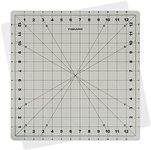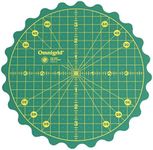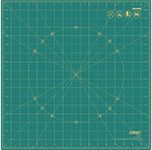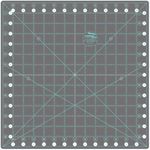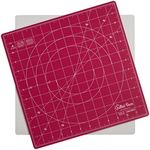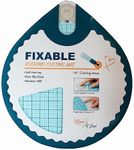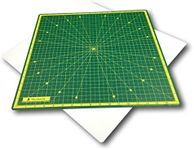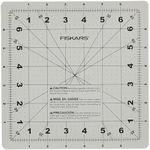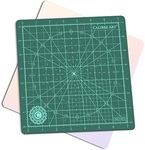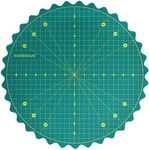Buying Guide for the Best Rotating Rotary Cutting Mat
Choosing a rotating rotary cutting mat can make a big difference in your crafting, quilting, or sewing projects. These mats are designed to make cutting fabric easier and more precise, especially when you need to make multiple cuts or work with intricate shapes. The rotating feature allows you to turn the mat instead of your fabric or your body, which helps keep your cuts accurate and reduces strain. When picking the best mat for your needs, it's important to understand the key features and how they relate to your specific projects.Mat SizeMat size refers to the overall dimensions of the cutting surface. This is important because it determines how much fabric you can work with at one time and how easily you can maneuver your materials. Smaller mats, usually around 8 to 12 inches, are portable and great for small projects or limited workspace. Medium mats, about 12 to 16 inches, offer a balance between portability and workspace, making them suitable for most home crafters. Larger mats, 16 inches and above, provide ample space for bigger projects but can be bulky to store. To pick the right size, consider the typical size of your projects and the space you have available for crafting.
Rotation MechanismThe rotation mechanism is what allows the mat to spin smoothly. This feature is important because it lets you rotate your work without lifting the fabric, which helps maintain accuracy and safety. Some mats rotate on a ball-bearing system for smooth, effortless turning, while others use a simple pivot or layered design. Smoother rotation is better for detailed work and frequent use, while basic mechanisms may be sufficient for occasional projects. If you often need to make multiple angled cuts or work with complex patterns, a mat with a high-quality, smooth rotation will be more helpful.
Self-Healing SurfaceA self-healing surface means the mat can 'heal' minor cuts and scratches, keeping the surface smooth and extending the mat's life. This is important because it ensures your cuts remain precise and the mat stays usable for a long time. Self-healing mats are standard for most rotary cutting mats, but the quality can vary. Thicker, high-quality self-healing surfaces last longer and are better for frequent use, while thinner mats may wear out faster. If you cut often or use heavy pressure, look for a mat with a reputation for durable self-healing properties.
Grid Lines and MarkingsGrid lines and markings are printed guides on the mat that help you measure and cut accurately. These are important for making straight cuts, measuring fabric, and aligning your work. Some mats have basic inch or centimeter grids, while others include angle lines (like 30°, 45°, and 60°) for cutting shapes and patterns. Clear, easy-to-read markings are essential for beginners and anyone who values precision. If you do a lot of geometric or angled cutting, choose a mat with a variety of angle guides and clear, contrasting lines.
Portability and StoragePortability and storage refer to how easy it is to move and store the mat when not in use. This is important if you have limited space or need to take your mat to classes or group crafting sessions. Smaller and lighter mats are easier to carry and store, while larger mats may require dedicated space. Some mats are designed to be lightweight or have handles for easier transport. If you need to move your mat often or have a small workspace, consider a mat that is easy to store and carry.
